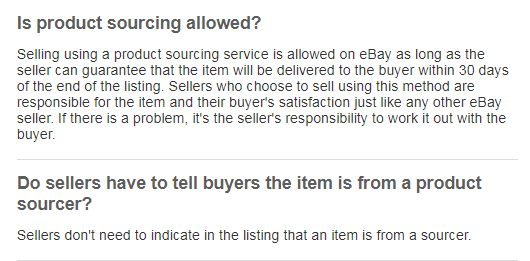I sold my first item on eBay in 2008, it was a $70 hair-straightener which was drop shipped to my first ever customer from a Chinese supplier.
Since that first sale, my business partner, Max and I, continued on an eventful journey of taking a dropshipping business from zero to over $4.5 million in annual sales. We’ve spilled a lot of blood, sweat and tears learning everything the hard way, from getting our eBay and Amazon accounts suspended, losing $20k worth of packages during a chinese postal service meltdown in Christmas of 2012, all the way to winning multiple awards for outstanding sales and lecturing on the biggest stages, passing our learnings on.

In this post I will share what we’ve learned during a decade of dropshipping on eBay, Amazon, and our own webstores. Hoping to inspire and help you start and grow your own successful and sustainable dropshipping business.
Understanding What Dropshipping is
My friends and I were always business enthusiasts, we tried and failed in a handful of initiatives. From trying to launch a travel website which never took off, to organizing a party at a nightclub, which resulted in each partner losing about $800 after weeks of hard work.
I’m sharing this background of failed attempts at starting our own businesses so that you’ll be able to easily understand why I got so excited about the dropshipping business model when I first found out about it.
I started my dropshipping business while I was a student, having absolutely zero capital to invest. What was most appealing to me was the fact that it literally required zero upfront investment to get this business started.
The Dropshipping business model means that the seller doesn’t keep a stock of the products. Instead, when the seller makes a sale, he purchases the product from the supplier who then ships it directly to the customer. This means that the seller never has to invest money in advance, he only pays the supplier a portion of the payment received from the customer.
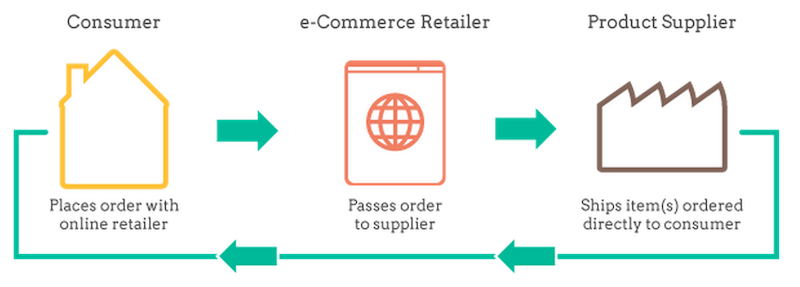
In my case, I listed a hair-straightener for $100 on eBay without ever seeing or handling the product. Only when a customer made a purchase and I received the $100 to my paypal account, did I pay the supplier the agreed upon sum of $70 for the product and shipping costs, resulting in a $30 profit (before deducting eBay and paypal fees).
By using this method, I made a profit of $700 during the first 3 days of dropshipping on eBay. I got so excited about this that I called up my friends and shared what I’ve learned. One of them, Max shared my excitement, and ten years later we’re still business partners.
Up until now it may sound too good to be true – dropshipping seems like a zero risk, high profit business model. Your hunch is absolutely right, as opposed to what the endless amounts of online dropshipping courses out there promise. Dropshipping, just like any other form of business, requires a lot of hard work, dedication and determination to succeed. Just like any other business model, dropshipping has its benefits and disadvantages.
Advantages and Disadvantages of Dropshipping
Below, I’ll outline the benefits and disadvantages of dropshipping versus a traditional retail business. So you can get a sense of how it is like to run a dropshipping business in real-life.
Advantages
- Zero Capital Required to Get Started – I was a student without a dime to my name when I launched my dropshipping business (I shared previously how we started eBay dropshipping with zero cash). You don’t need to buy any product inventory upfront, you only pay the supplier a portion of what you get from the customer.
- Work from Anywhere – Having suppliers dropship for you, basically means you have partners taking care of all physical aspects of running your business, while you’re in charge of the digital aspects – listing products, marketing, optimizing, supporting customers etc.
After a year or so of running our small dropshipping business, Max, Dima (our first employee) and I realized we could work from anywhere in the world as long as we had a Wifi connection. And so, we packed our laptops and flew to work from Dubrovnik, Croatia (where many Games of Thrones scenes where filmed!). - Scalability – Whether you’re dropshipping a $1 mobile phone case or a $2,000 piece of furniture, the amount of work for you is the same, you basically need to transfer the order information to your supplier. This means that a dropshipping business is highly scalable and is virtually only limited by the processing capacity of your suppliers. Even then, if your suppliers have limited stock or can’t handle the volume of your orders, you can source another dropship supplier.
After being hit by “Out of stock” problems on several occasions, Max and I started to insure ourselves by striving to have at least one alternative drop ship supplier for every line of product we offered.
We were also much more careful when choosing dropshipping suppliers, in some cases traveling abroad to meet them face to face.
- Endless Selection of Products – Having no need to actually purchase or store your own inventory, means that you can offer a very wide variety of products and let the sales data drive your business expansion.
In our case, we were dropshipping over 1,000 products on eBay and Amazon and saw a constant demand for our filming equipment from UK based customers. This data drove us to a decision to open our own UK targeted webstore – https://gripup.com/. If we had to buy the products upfront, we would not be able to list so many products and discover the UK demand within several weeks.

In the above image, you see the laptops on the kitchen table to my right? This was our office in Dubrovnik, Croatia.
The following year we flew to work from Costa Brava, Spain:

Disadvantages
- High Risk – All physical aspects of the business are out of your hands. While you must commit to a high packaging quality, quick handling and shipping times and stock availability, all of these aspects are out of your control and you need to rely on your dropship suppliers, who are often times from the other side of the world and have a different business culture than yours.
There are a lot of moving parts which are out of your hands. It can be very frustrating having to communicate with angry customers because your supplier messed up his part. - Low Profit Margins – The entry barrier to the dropshipping world is relatively low, which means that it’s a very crowded space. This is especially true during the last few years. Take a look at this google trends graph, showing interest in dropshipping over time:
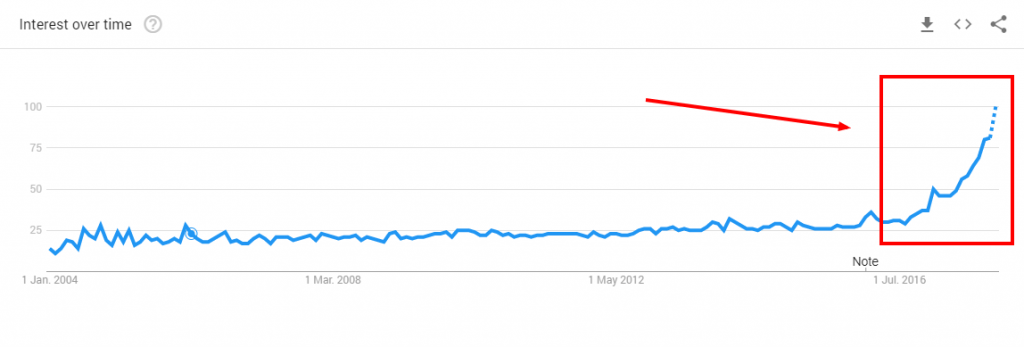
Dropshipping is booming in recent years.
Sellers must find a unique competitive advantage in order to stand above the competition and generate substantial revenues.
I’ll say it again – dropshipping, like any other business, is damn hard. Only the stubborn, focused and determined will succeed.
3. Slower Shipping Times – According to studies, shipping time is a top factor in an online shoppers buying decision. It won’t be long before Amazon will fly its drones to your doorstep with the package you’ve just ordered a few hours or even minutes ago.
Dropshipping your orders from suppliers instead of managing your own logistics usually means slower shipping times.
In our UK business, we were pushed by shoppers demand to start and keep our best sellers in stock to stay competitive with the local market in terms of delivery times. While some shoppers were happy to wait a few extra days while we drop shipped the product to them from overseas, others prefered to pay more and to get their order delivered within 24h. The later only became possible when we began keeping a small stock of our best sellers.
This was a major pain, as at the time Oli, our business partner from the UK, was a filmography student living inuniversity dorms. We actually had UPS deliver packages to Oli’s dorm room for over a year until we were able to afford renting a small office in London.

The 3 Different Forms of Dropshipping
Back in 2008 when Max and I were making our first steps in the eCommerce world, dropshipping was widely regarded to as a specific service offered by suppliers: individually ship products to the end customer.
Manufacturers and wholesalers who had the logistical capabilities to do this basically offered a “dropshipping service”.
Nowadays dropshipping evolved to have multiple shapes and forms.
Beyond the “classic” dropshipping service, sellers are now dropshipping from Amazon and other online retailers, as well as utilizing Amazon’s FBA service (fulfilled by amazon) to have Amazon dropship their products for them.
Below is a summary of the different forms of dropshipping, broken down into benefits and disadvantages, accompanied by insights from our own experience.
#1: Dropshipping from Suppliers
This is the form of Dropshipping that Max and I launched our business with. We established personal relationships with dropshipping wholesalers and manufacturers who shipped their products directly to our end customers.
We negotiated business terms with the suppliers, and then listed their products on our eBay and Amazon accounts as well as on our webstores.
Again, all of this without ever seeing, owning or touching the products.
Benefits of Dropshipping from Suppliers
- Real Value Creation – As opposed to dropshipping from Amazon, Aliexpress or other platforms, establishing relationships with real life suppliers is a sustainable business that adds substantial value to the world.
For example, we advertised products from Chinese and Indian suppliers who often didn’t have the skills or resources required to market their merchandise to the Western world.
We were not just a “middleman” in the supply chain, rather we had a lot of room to create value for the customers. From creating professional, descriptive and appealing product listings to providing world class customer support to effectively bridging the gap between the Eastern and Western business cultures.
Here’s one example to illustrate what I mean:
When a customer complaints about an item arriving broken, a Chinese supplier would often ask the customer to ship the item back on the customers expense, while for us it’s obvious that the customer did nothing wrong, and not only that he shouldn’t pay the return shipping cost, but we must also compensate him for the inconvenience. - Having a Partner Who Cares for Your Mutual Interests – When you use a dropshipping service, you basically give control over all physical aspects of your business to your dropshipping supplier. In case $#it hits the fan, and believe me, it will… you want a partner who genuinely cares about your mutual success.
When the Chinese postal service lost over $20K worth of packages of ours, our Chinese supplier was all over the postal service, getting us daily updates on the situation, helping us communicate the most up to date status to our rightfully furious customers.

3. Personal Relations With Your Supplier Can Make a Huge Difference – When Max and I had one of our numerous cash-flow crisis situations, one supplier whom we took to dinner during an exhibition in Amsterdam, granted us with a $20k credit line which helped us get through the hard times.
Disadvantages of Dropshipping from Suppliers
- Hard to find – Finding a great dropshipping supplier is among the most critical factors of success. Fact is, it may take weeks or months of hard work until you find the holy grail; a professional, communicative dropship supplier whom you can trust as your business partner.
- Lots of Room for Human Error – At the end of the day you heavily rely on your communication with the supplier. For example, if he fails to correctly update you of his stock levels, you are running at risk of overselling an item that you won’t be able to fulfill. Realizing that reputation is more important than the immediate profit, in these relatively rare cases, when our suppliers ran out of stock without promptly notifying us, we would source the product from an alternative, usually more expensive supplier or from Amazon / Walmart etc. The profit margins are extremely low, and so this would usually mean we would lose money on that order.
You may wonder why not simply tell the customer that we’re out of stock and cancel the order? The thing is that on all online marketplaces an order is a binding contract between the seller and the buyer, canceling an order is considered highly unprofessional and often times results in a negative feedback/review on the seller’s profile, which costs 10’s if not 100’s of other potential shoppers to stay away from you as a seller.
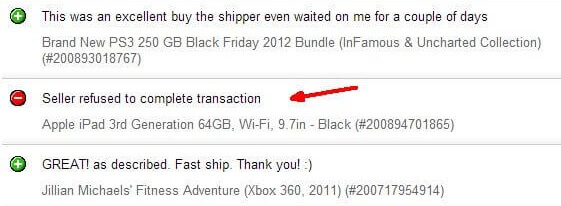
3. Relationships Require a Lot of Attention and Nurturing – As opposed to dropshipping from other platforms, when you deal with human suppliers, you need to communicate well and often. It usually means daily communications over email / Skype / phone etc. While this is what it takes to build real partnership relations with your dropship supplier, it’s a major time consumer.
#2: Dropshipping from Amazon and Other Online Retailers
This is also known as the arbitrage dropshipping model. The seller would basically look for a price arbitrage between two online retailers, usually between any of these: Amazon, eBay, Aliexpress, Walmart, Sears, Target and Overstock .
Here’s an example:
A seller would find a $50 item on Amazon that is sold for $60 on eBay, he can then exploit this arbitrage difference and make a profit by selling the item on eBay while ordering it on Amazon (we dedicated a detailed post to dropshipping from Amazon to eBay).
In this case, instead of establishing relationships with real life suppliers, the seller basically purchases the items directly from Amazon. When an eBay shopper buys the item for $60, the seller immediately goes to Amazon and buys the item for $50, using the eBay shoppers’ address as the shipping address for the Amazon order.
Benefits of Dropshipping from Amazon and Other Platforms
- Low Entry Barrier – No need to establish relations with suppliers, you just need to find the price differences (arbitrage) between two online platforms and start selling.
- Multiple Suppliers for The Same Product – For most items on most platforms there are multiple suppliers offering the same item at different price points. This means that even if one supplier runs out of stock, you’ll be able to fulfill the order from others.
Here are multiple suppliers on Amazon offering the same keyboard:
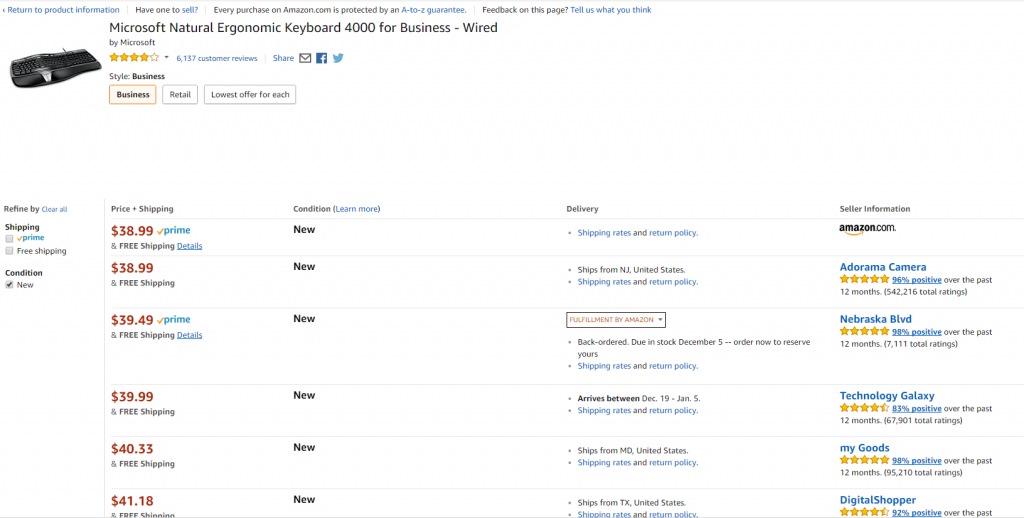
3. Abundance of Automation Tools – Once you combine all the pieces of the puzzle together, you can pretty much automate all the aspects of your dropshipping business except for customer support.
Solutions like: PriceYak, Salesfreaks, DsmTools, ProfitScraper, Easync.io and Yaballe Will:
- Automatically scan platforms, looking for price arbitrage you can exploit.
- Automatically list products for you.
- Automatically re-price your listed products according to price updates on the source platforms.
- Some will even automatically place the order for you on the source platform.
With all of the above being automated for you, you will be left with the task of making customers happy via great customer support.
Disadvantages of Dropshipping from Amazon and Other Online Retailers
- Not Sustainable – Having an automated “magic” machine generating side income for you sounds very exciting, however, unfortunately it’s not the case. As I’ve illustrated above, the market is saturated with dropship enthusiasts who are mainly looking for quick profit. The competition drives the profit margins to such a low point that even a small percentage of returns and cancellations may run you out of business.
Here’s an example:
Say you’re selling a $30 watch. If you earn $1 per order, and generate 10 orders a day, your profit margin is $1×10=$10 / day.
In case one customer is not happy with his order, or the package arrives damaged (it happens), you will have to cover the return shipping costs, that will often times be even higher than your daily profit margin of $10. - No Real Value Creation – Our decade in business taught us that you can only expect to earn an equivalent amount of value that you create for the world.
Steve Jobs gave us all a computer the size of our palm (the Iphone) – thus the world made him a billionaire. Same goes for Bill Gates and Windows, Walmart / Costco / Amazon and their unbeatable prices and super efficient logistics. If you want to build a profitable business, you need to focus on creating value for your customers, your own profit comes second.
Selling an item on eBay that is available on Amazon for $10 less, creates little to no value to the world. There are folks out there who are very much used to the buying experience on eBay, who are reluctant to buy on Amazon, but this segment of shoppers is ever shrinking, and the new generations are becoming very much platform agnostic, they know to search the web for the best deal.

3. Cross-Platform / Arbitrage Dropshipping is Against The Interest of The Platforms – Take eBay for example, who are actively battling Amazon dropshipping. When an eBay shopper is receiving an item in an Amazon package, he’s badly surprised and is highly likely to make his next purchase on Amazon directly, never coming back to eBay.
This is not to say that eBay is against dropshipping as a business model, quite the opposite, here’s a link to the ebay drop shipping policy:
Dropshipping from Amazon to eBay is a model eBay is looking to eradicate from the platform.
Amazon has pretty much the same policy, dropshipping is a legitimate sourcing form, however you’re not allowed to sell products on Amazon sourced from other online retailers (Such as Walmart, Sears, eBay etc.)
4. Impossible to Generate a Profit Working Manually – Back in the day, one could make a decent profit from manually running an arbitrage dropshipping business. Today it’s a battle with automation solutions which are driving the margins to the very minimum. You simply can’t compete with players who list 1000’s of items automatically. As I’ve mentioned before, even if you use the automated solutions, you’re competing with tons of others who are doing the same, which leaves very little room for profit.
5. Requires a Large Volume of Sales to Make a Profit – Again, because the profit margins are so low, the only way to make a decent profit is to sell large volumes. In order for platforms like eBay, Amazon or Walmart to increase your selling limits, you need to patiently build mutual trust and business relations, which takes time and effectively limits the profit potential for the first year or so.
#3: Using Amazon FBA for Dropshipping
This dropshipping model is based on using Amazon’s fulfillment services, launched in 2006 – FBA (Fulfilled by Amazon) to fulfill your orders.
The seller ships his products in bulk to one of Amazon’s warehouses, Amazon then stores the inventory and ships to individual customers as orders come in.
Sellers can use FBA to fulfill their Amazon orders as well as orders received from any other sales channel. Forexample, you can sell on eBay, Amazon, Walmart and your own webstore and fulfill all of these orders from your FBA account.
Amazon incentivises sellers to focus their sales on the Amazon platform by providing a discounted FBA handling and shipping rate for orders generated on Amazon itself.
It’s important to note that this is not a pure dropshipping business model – you need to purchase and store your inventory at Amazon’s FBA warehouses.
This model is more popular among experienced sellers who have significant traction and enough data to forecast the demand for their products.
Benefits of using Amazon FBA for drop shipping
- Fast and reliable – You’re basically partnering with the best logistics operator in the world. You can rest assured that your orders will be processed and shipped fast.
- Items you list on Amazon itself will enjoy the following benefits – Being eligible for Super Saver Shipping, Amazon Prime and Buy Box. These are highly likely to lead to higher conversion rates. Amazon also handles the returns for you – from talking to the buyer to shipping a replacement product.
- Higher margins – You will usually get wholesale pricing when you purchase a bulk stock, this is opposed to dropshipping individual products from suppliers and from other online retailers where prices are higher.
Disadvantages of using Amazon FBA for drop shipping
- You pay for storage – this means you are incentivized to only have your best sellers stored in FBA, as opposed to working with dropshipping suppliers which doesn’t require you to pay any storage fees because you don’t ever see, handle or own the products before you sell them to the end customer.
- FBA costs a fee that eats up your margins.
- Co-mingling inventory – Amazon sorts and stores products from 10’s of thousands of sellers. If you ship a pallet of product X to Amazon, it will be likely stored together with the rest of product X from other sellers. This leads to a situation where the product that ships to your customer may not necessarily be the exact one you sent Amazon.
The solution to this, is to have Amazon add a SKU-level sticker to your items, at about $0.2 per item. This may seem like an overkill, but it’s lower to pay this marginal fee than to have your Amazon account suspended for apparently selling counterfeit co-mingled product to your customer.
Now that you’ve got a good understanding of dropshipping as a whole as well as the ins and outs of the different forms of dropshipping , you can clearly see that I’m a big advocate for dropshipping from human suppliers. With that said, I personally know a handful of successful businesses doing each of the described dropshipping forms.
How to start a dropshipping business

You Don’t Need Money to Start a Dropshipping Business
Max and I started our dropshipping business while being students.
I was bringing my laptop to classes, but I was busy with listing new products to eBay and talking to suppliers rather than taking notes during the lectures.
Luckily we didn’t have much money, which forced us to build our business slowly, step by step, making all the possible mistakes at small scale.
Over the years I’ve seen plenty of sellers making the mistake of thinking that funding will turn their dropshipping business into an overnight success, despite having no traction or experience with eCommerce and dropshipping.
I’ve seen companies invest 10’s of thousands of dollars building robust automation systems before making a single online sale, this is a mistake.
Our experience is proof that time is the most valuable resource you have, not money.
Have a Day Job? Start a Side Dropshipping Business
Contrary to popular belief, the best entrepreneurs are actually more risk averse than the average person. Take Pierre Omidyar, founder of eBay. Pierre only quit his day job as a programmer when eBay began generating an income bigger than his salary from programming.

My advice is start small, get to initial traction, and only when you have enough stable income from dropshipping to make a living, quit your day job.
Finances and Incorporation
Max and I had zero experience with running a business, so for the first year or so, we didn’t separate between the business and ourselves as individuals.
We were using our private banks, visa cards and paypal accounts, didn’t register any form of business and generally speaking were focused on generating sales and pretty much neglected book keeping altogether.
I wish we had someone to guide us at these early stages, I can’t stress enough, how important it is wto get your business registration, finances and bookkeeping in order as soon as your business turns real.
I’m not saying register a company, hire an accountant and open a dedicated bank account before you make your first dropship sale. I am strongly suggesting that as soon as you see that your business is not just a few casual transactions, rather, you’re getting a steady monthly turnover north of $500 – do yourself a favor, and do invest time and little money in these 4 steps:
- Set-up the most simple form of business available in your country – in the US and Israel it’s called “Sole Proprietorship”.
- Set up a business bank account + a credit card.
- Set up a business Paypal account.
- Find a bookkeeping professional with proven experience with eCommerce. It should cost pennies at this stage, and will save you a lot of trouble down the line.
Below I’ll share how I actually made my first ever dropshipping transaction on eBay.
How Dropshipping Works? A Real-Life Example
For this case study I’ll simplify things so you’ll get a good feel of how dropshipping looks “in real life”. I will later discuss the various steps in detail.
I started by browsing Aliababa.com, searching for potential products to dropship on eBay. The first item that caught my attention was a hair straightener.
Finding a Dropshipping Supplier
Not really knowing what’s a good cost for a hair straightener, I’ve searched Alibaba.com for a “hair straightener”, ticking “online” to make sure all of the suppliers I find are available for a chat.

I then simultaneously opened multiple chat windows with different suppliers and basically negotiated with all of them at once. When supplier A quoted me $80 per piece, I told this to Supplier B who then immediately offered $75 and so on until I got to the best possible price 🙂
Once we’ve agreed on the price and discussed shipping and returns terms, I set out for the listing process.
Listing My First Ever Item on eBay
Back in 2008, realizing that a professional listing will help me generate sales, but having no HTML coding skills and no solutions like CrazyLister to help me out, I settled for Microsoft’s html editor, Front page. It allowed me to at least add some visual elements to my otherwise boring textual item description.
After more than 10 hours of messing with Front-page, my listing was finally live on eBay! The next day I’ve already began receiving questions from customers.
Answering Customers Questions
I remember how surprised I was with the questions I got. Customers surfaced issues I didn’t even know I should discuss with my dropshipping supplier!
For example: Shoppers from Australia were asking if the hair straightener is compatible with their power outlet and voltage. I didn’t have a clue… So I contacted the supplier and then added this information to the eBay listing, making it easier for the shoppers to get critical info they need for their buying decision.
This process of optimizing eBay listings is what helped us grow the business quickly (we shared the other eBay selling hacks in a dedicated post)
Your eBay Item Is Sold!
Ding-Ding-Ding!!! I’ve made my first ever dropshipping sale on eBay!
My first ever customer on eBay, was a girl from Norway named Kristine.
I got $135.39 on paypal (before fees) and now needed to pay the supplier to ship Kristines order to her.
Processing the Dropship Order With the Supplier
After sending millions of dollars to suppliers from all over the world, this next part seems ridiculous to me today. At the time, I was so afraid to mess something up when sending a paypal payment to the dropship supplier that I asked him that we run a test transaction of $0.01 to make sure he gets the money and everything is ok.
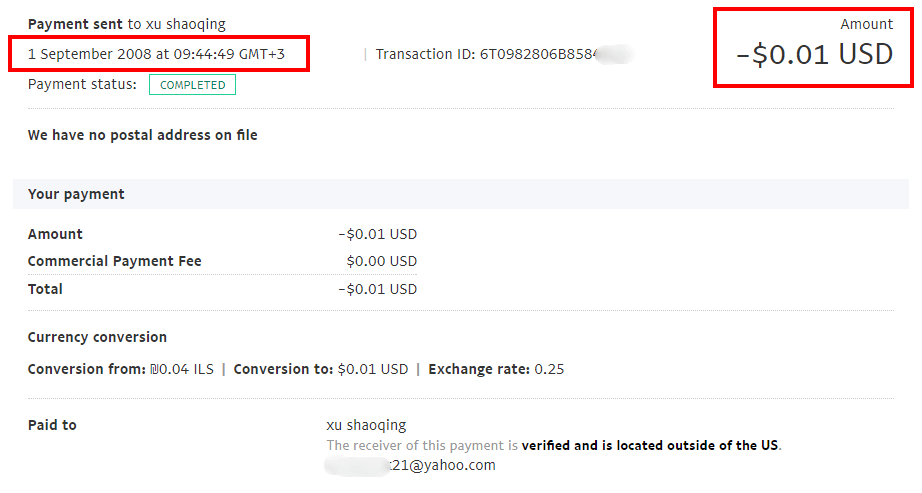
When the supplier confirmed receiving my test sum of $0.01, I submitted the agreed upon cost of $65 (which included shipping).
The next day, the supplier processed the order and sent me the tracking number. I submitted the tracking number on eBay and updated Kristine that her order was on its way to her.
Calculating the profit
Here’s the simplified math:
- Income: $135.39
- eBay and paypal fees (aprox 12%): $16.25
- Cost of goods and shipping: $65
- Total profit: $135.39 – $16.25 – $65= $54.14
Pretty good for the first ever sale, right?
Again, this is not a precise calculation as there are fees involved with withdrawing the funds from paypal to the bank account, a currency conversion fee and taxes. t this stage I didn’t take all of this into account.
Don’t take this stage lightly, it’s critical to know your exact costs when selling on eBay, I’ve written a complete guide to help you calculate your eBay profits accurately.
For the next 3 days I netted a total of over $700 in profit, and that’s when I gathered my friends and told them about the business opportunity I was so excited about.
Further in the post I’ll detail every step of the dropshipping business, sharing our wins and fails for you to learn from.
Picking the Best Drop Shipping Products
One of the hottest subjects in dropshipping is finding which products to sell, and many people make the mistake of thinking that the most sold items are the best items to sell. There is a clear distinction between the top selling items and the best things to sell. These are a few guidelines I suggest to follow when picking the best drop shipping products:
1. Focus on Adding Value to the World – How do you decide if you can add value? Here’s a simple test. Ask yourself: What can you do better as a seller of this item than Amazon can do with their unbeatable prices and streamlined logistics?
I bet you’ll find this question hard to answer for a branded smartphone. Amazon will offer a lower price and a faster shipping, there’s not much more you can offer a customer in this case.
However you’ll probably find room to add value selling professional security camera systems.
Shoppers in this category will probably need expert advice and guidance that cannot be offered by Amazon, the “all-in-one” store.

Max and myself found multiple opportunities to add value over the years.
One example is bridging the gap between eastern manufacturers and western customers.
While manufacturers are great at creating high quality products, they usually lack the skills and expertise to effectively market their products to the end consumers.
Realizing this, we were “hunting” manufacturers on eBay. We would manually go through listings of products, looking for eBay accounts that seemed like manufacturers. When we would find listings that looked unprofessionally designed and unappealing, we would contact the seller offering them to become our dropship suppliers. Many times the manufacturers were more than happy to have professional sellers help them resell their products.
2. Look for Niche Markets and Categories– The largest markets and categories tend to be dominated by the largest players. Start by making a niche market super happy and expand from there. Here’s an example I often give to emphasize this idea:
Say you’ve decided to manufacture and sell earphones under the brand name x-earphones. If your target market will be “Anybody who looks for earphones” and your marketing message will be “The best earphones for everybody”, it’s highly unlikely shoppers will choose your anonymous x-earphones brand over Sony, Apple, Panasonic etc.
However, if you start by focusing on a niche market “The best earphones for professional swimmers”, and you’ll focus on truly understanding the pains and needs of the swimmers, you have a good chance of building a mini-brand among them, and then you can further expand to the next level “Best waterproof earphones” then “Best sports earphones” then “Best outdoor earphones”, well, you get the idea…
3. Products Priced Around $100–$300.
Two arguments for this specific price range:
a) The work required from you to process a dropshipping order is the same regardless the price of the item. You basically need to send the supplier the order info. The higher the item is priced the higher your gross margin will be.
b) Following the previous point, why not sell $10,000 priced items? The reason is that shoppers feel confident spending $100-300 without meeting or speaking to the seller, while higher ticket items lead to heavy fingers on the buying trigger. Shoppers will be less prone to instinctive buying and will want to get more info and speak to the seller before making a purchase. I’m not saying it’s impossible to dropship expensive items, it definitely is possible. Our own record is a video filming crane priced north of $10,000, but I can count on one hand the number of transactions we completed in these price ranges.
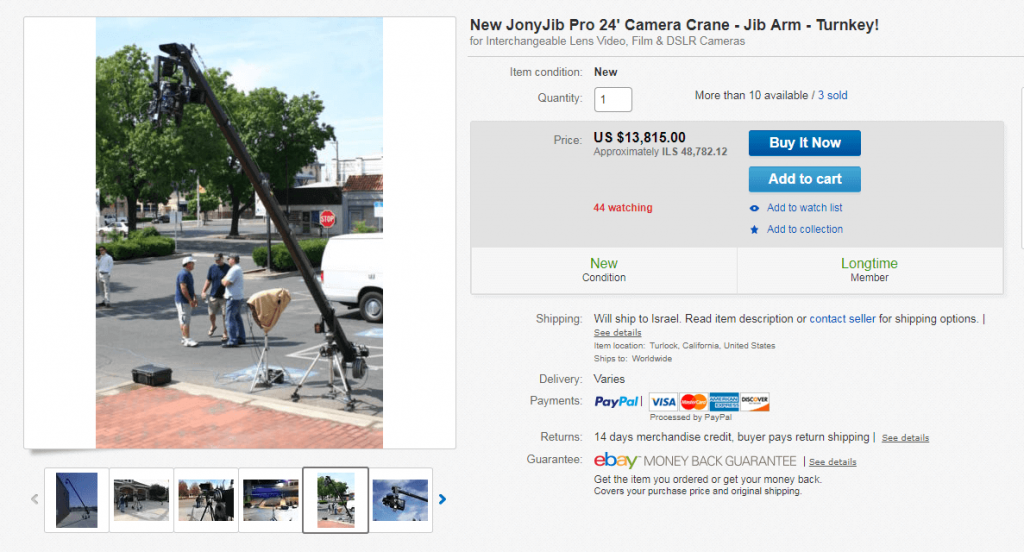
Once you’ve found potentially interesting products, it’s time for the most important task of all – finding and starting to work with dropshipping suppliers.
How to Find Drop Shipping Suppliers
I can’t stress enough the crucial part dropship suppliers will play in your business. They completely control all physical aspects of your business, from packing and shipping to handling returns and refunds.
At this step you’re not just looking for another piece of the dropshipping puzzle, rather you’re looking for a business partner. If you can find a professional, trustworthy, communicative dropshipping supplier, you’ve done 50% of the work required to build a successful dropshipping business.
Below I will share how we’ve found and connected with 10’s of great dropshipping suppliers over the years.
Alibaba Suppliers
As I’ve shared earlier, I found my first ever dropshipping suppliers on Alibaba.com – a B2B marketplace where (mainly Chinese) manufacturers and wholesalers offer their goods. While many indicate a MOQ (minimum order quantity), most will be happy to dropship for you for a slightly higher price per unit.
Alibaba allows you to have live chats with the suppliers. As a new seller it was critical for me to be able to ask lots of newbie questions and have timely answers.
The live chat also allows for quick and effective bargaining to drive your price per unit to the absolute minimum. Tip: Chinese love to negotiate, the advertised price is always just the starting point 😉
Wholesalers Websites – The Uglier the Better!
Everybody plays their part in the value chain, manufacturers produce, wholesalers distribute to retailers, and we (retailers) market and sell to the end customers.
For the most part, retailers have the most experience and skills to effectively market to the end consumers. We’d better have – this is what we do for a living! We talk to end customers every day and we compete with other retailers on customers attention.
This is not usually the case for wholesalers, who are required for different strength points to succeed.
This is why a retailer’s website will usually be much more professional and visually appealing than a wholesalers one.
In fact, a basic looking website was one of the indicators of a legitimate dropshipping supplier, and not a retailer who’s pretending to offer a dropshipping service and is just another middlemen in the value chain.
Here’s a website by one of our first dropshipping, wholesale suppliers from the US Rightwayfitness.
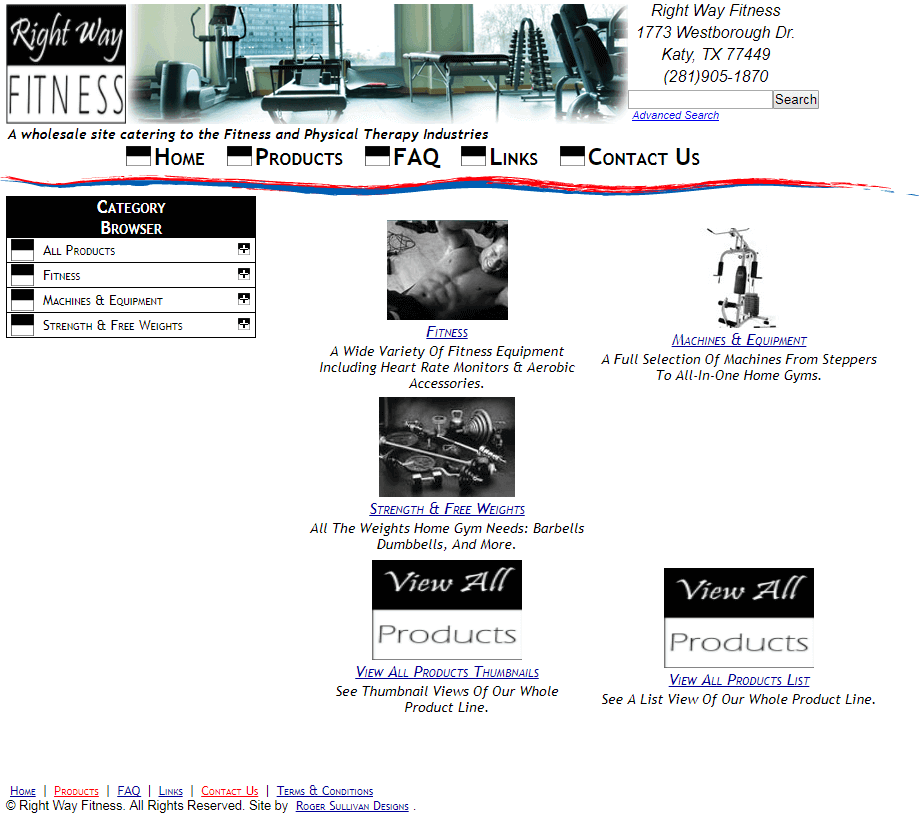
I started working with Rightwayfitness almost a decade ago (in 2008), and today while conducting the research for this post, I was amused to see that the website is exactly the same as it was when I first found him!
The supplier simply never had the need to invest in a modern website, he’s not facing end customers, he’s working with retailers like us who are doing the heavy lifting of wrapping his products in professional product listings and descriptions.
Interestingly enough, in the time of writing these lines (Dec 2017) B2B eCommerce is making a shift towards a B2C experience. Wholesalers who are used to do business over the phone with the manufacturers sales teams, are now expecting to get the same B2C experience they have when doing their private shopping on eBay or Amazon. This phenomenon is pushing manufacturers and wholesalers to invest in high-end websites.
But that’s another story.
Another interesting aspect to note is that wholesalers are usually not good with SEO (search engine optimization), which means that you will usually not find their websites on the first pages of a google search, you’ll have to dig deeper, way beyond page 1.
Finding Dropshipping Suppliers on eBay and Amazon
How great would it be if there was a directory with millions of suppliers, who are all offering a dropshipping service. Feedback would be transparent, so you’ll be able to easily see what customers think of the suppliers service and products quality. Price would be transparent as well, and you’ll have a good idea of what price per unit the supplier is able to offer you.
Think about it for a minute – eBay and Amazon are these directories.
If you know how to spot the manufacturers and wholesalers, this is probably the easiest method to find great, professional dropshipping suppliers.
Max and I would look for eBay and Amazon sellers that had the same brand in their product names and in their account names –

This is a strong indicator that this eBay account is either an official wholesales for this brand “Zosi” or the manufacturer himself.
You may wonder, if the manufacturer is selling directly on eBay, would he need you as a retailer to re-sell his products?
The answer is, yes, because sometimes these suppliers will not want to work with you. But often times you can create a massive value for them in various forms:
- Offer to sell their products in geographies they don’t sell to.
- If their product listings are non-professional, you could market their products better, even on the same eBay site.
- You can sell their products on other marketplaces and on your own webstores.
Tip: I’ve previously dedicated a post to the email templates we used to connect with suppliers.
Dropship Manufacturers
It’s important to understand that dropshipping is a service, not a role. There are plenty of manufacturers that have designed their logistics in a way that they can offer a dropshipping service.
These guys are usually similar to Tesla or Amazon – they want to dominate the whole supply chain, from manufacturing to retailing to end customers. eCommerce is overwhelmingly large and complex, and they quickly discover the benefits of working with professional retailers to re-sell their products.
While it’s possible to reach such suppliers via the internet, the best method we ever used to connect with dropship manufacturers is meeting them in person in exhibitions.
The mere fact that you dress up nicely and fly to an international conference, is a natural filter that signals to all of the suppliers in the exhibition that you worth their time.
Max and I flew to our first ever exhibition in Amsterdam, and returned with more than 10 new relationships with dropship manufacturers we’ve had the pleasure to meet with in person.

Drop Shipping From Amazon
I’ve discussed this dropshipping method earlier in this post, while covering The 3 Different Forms of Dropshipping.
While we never used Amazon as a regular dropship supplier, and always worked with human suppliers, if on the rare occasion we got stuck with an order that our dropship suppliers couldn’t fulfill for whatever reason – we would usually place the order on Amazon.
We prefer not to make a profit or even lose some money than to cancel the order and seem unprofessional to the end customer.
Other Methods to Source Dropship Supplier
There are several additional methods to find dropship suppliers, which we never used ourselves but know lots of sellers who do.
Dropshipping From Aliexpress
Pretty much the same as dropshipping from Amazon, with the benefits and disadvantages that come along with this method.
Dropshipping Directories
These are basically lists of vetted suppliers who offer a dropshipping service.
When I was just starting out, I bought a directory membership for $30.
It did help me to reach one dropship wholesaler from the US from the sporting goods category.
Overall I never came back to directories, as when you know what you’re looking for – the same suppliers are available on the internet for free.
Directories are good at giving you an idea of what products can be dropshipped. If you combine what you’ve read under “Picking the Best Drop Shipping Products” in this post, with some research on eBay, you’ll get a much more accurate idea of what to sell.
There are several leading dropshipping directories out there:
Doba, Worldwide Brands, SaleHoo, Wholesale Central
I was always skeptical about these, mainly because the more famous the directories are, the more sellers have an easy access to the suppliers on their lists, which means a low entry barrier, which indicates lots of competition and low margins, but that’s just my 2 cents. I always believed that the more work we put into sourcing great suppliers, who don’t know how to advertise themselves, the better the business we could build out of creating partnerships with such suppliers.
How to evaluate dropshipping suppliers
Generally speaking the saying “when the going gets tough the tough get going” is very much true when evaluating your dropship supplier and business partner.
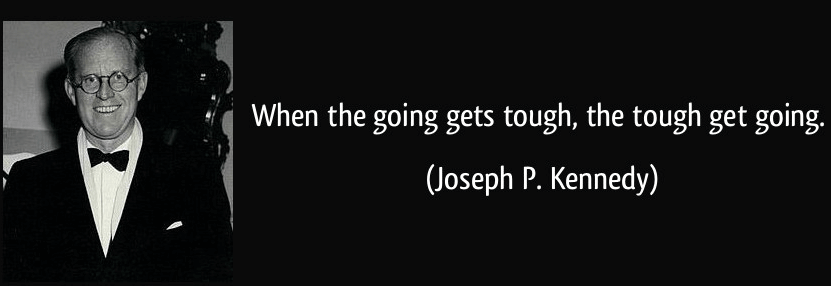
You can only really measure the professionalism and your relationship with a supplier when you are both pushed to the edge. When the Chinese mail lost $20K worth of our packages, our dropship supplier could have easily disconnect contact with us, instead he did everything in his power to help us through the crisis.
With that said, creating a $%it storm in your business to vet a supplier is not a very effective method. At the end of the day there was one most important parameter that we’ve found to correlate with how professional a supplier is – communication skills.
More often than not, your supplier will be from a different time-zone, sometimes country, and even from a different continent. Your business will win or fail depending on how well you and your dropshipping supplier communicate.
In this sense, language is not an excuse for a barrier, we were working with suppliers from China, Hong Kong, India, Czech republic and other non-native english speaking countries. If a human being wants to communicate and understand you, he will.
Now that we’ve covered how to research products and find dropship suppliers, I’ll discuss the sales channels you can use for your dropshipping business.
Dropshipping Sales Channels
Starting with dropshipping on eBay, over the years Max and I expanded our sales channels to Amazon and our own webstores. We’ve drop shipped on international eBay and Amazon sites, as well as utilized comparison shopping engines, social media and Google shopping to drive traffic to our webstores.
Here is how it all happened.
eBay Dropshipping
eBay was the first channel we dropshipped on. After the first two years or so, we had a small but steady monthly revenue of around $2,000. The profit we were left with was basically no more than beer money.
We were mainly selling sporting goods, dropshipped by the US based supplier I’ve mentioned earlie, Rightwayfitness.
We called our eBay store – Smileyfitness, and our logo looked like this –

We were struggling to grow our business. Being yet another reseller to offer products from a US based wholesaler to the US market left us with very small profit margins. We were selling in a very competitive marketplace, with a low entry barrier and offering no added value compared to the other resellers. Then we found our unique value proposition.
Finding Our Unique Value Proposition
In 2010, I ordered a car GPS device from a chinese seller on eBay. The listing was poorly designed, it was basically a “wall of text”. Subsequently I didn’t have high expectations from the product itself, after all, the eBay listing design screamed “low quality”.
Then I got the GPS and was pleasantly surprised that the listing did a very poor job at conveying how good of a quality this device was.
That’s when it hit me – bridging the gap between great products and suppliers and poorly designed eBay listings is how we can create added value!
Funny enough I’ve contacted the seller of my GPS and asked if he would dropship for us, the supplier, Jamin, happily agreed. This was the starting point of a years long prosperous business partnership between 2 Israeli based sellers and a Chinese dropship supplier.
Our value proposition became: Professionally designed eBay listings convert better and generate more sales.
Six months later, after constantly improving the look and feel of our listings, Max and I were generating more than $100,000 / month on eBay, and were awarded with a certificate of achievement for the “Highest conversion rate” for being the best GPS sellers on eBay.

Max and I have no coding or design skills. I initially struggled working with freelance designers and then learned some Photoshop skills on Youtube. This is how I was able to create our eBay listings. It was an unbelievably hard process to create professional eBay listings, which led us to the notion that we mustn’t be the only sellers struggling with this, a thought that gave birth to CrazyLister, but that’s another story 😉
Here’s a Summary of Our eBay Dropshipping Experience:
Benefits of Dropshipping on eBay:
- Trust – Why would an Australian customer trust an Israeli seller with a $100 worth of a product? Because eBay’s brand provides this trust net. eBay’s marketplace allows complete strangers to safely trade with each other. Until you create at least a mini-brand for your business (which can take years), shoppers will feel more comfortable when there’s a well known 3rd party like eBay as a mature adult guarding your transaction.
- Great for Newbies – eBay does the heavy lifting of driving relevant traffic to your listing.
You can have the best products in the world with the lowest prices, but if you don’t know how to effectively generate relevant traffic to your product listings – you won’t generate any sales. This is what eBay exists for; to connect shoppers with sellers so you as a seller can focus on what you do best, not on traffic generation. - Room for Unique Value Creation – As opposed to Amazon, where generally speaking sellers aren’t able to design their own listings, eBay allows any seller to 100% customize their item description with visual elements and HTML coding. We utilized this to grow a 7 figure business on eBay.
Disadvantages of Dropshipping on eBay:
- Low Entry Barrier – Anybody can easily start selling on eBay, which means that it’s a very crowded and competitive marketplace. The pie is large, but there’s a limit to the size of the piece you can get when you’re one of millions of sellers competing for the same shoppers.
- Selling Fees – eBay charges a listing fee as well as a “final value fee”, these come to around 10%. This is a well deserved fee in light of eBay driving relevant traffic to you, but 10% is a very large portion of your profit in dropshipping, where margins are usually lower than 20% to begin with.
- You’re Helping eBay Grow Rather Than Growing Your Own Asset – eBay is built around products, not around sellers. Which means that you can’t expect much repeat business, no matter how great your service is, because the next time your customer comes to eBay he’s highly likely to search for a product, and not necessarily search for your specific account. This is opposed to having your own webstore, where shoppers will usually return to if they were happy with your service. Every sale you make on eBay helps eBay grow as a brand and company, while for you there’s little to no value beyond the monetary profit, your brand as a retailer doesn’t grow on eBay, your eBay account is not an asset of yours it’s more of a “rented” business. While eBay is a great place to start dropshipping, I would argue that you always want to strategically plan to grow your dropshipping business to expand beyond eBay.
Amazon Dropshipping
While we did well on eBay, we had our share of problems – there was no dedicated support for Israeli sellers. We were struggling, wasting hours on the phone solving all the pains of a growing business. It was absurd to us that our best selling listing was removed by eBay claiming we used an unauthorized image, without giving us the opportunity to prove that it was indeed legit.
So we decided on a strategic goal to expand our dropshipping business to more sales channels. The next destination was Amazon.
I actually had to fly to the US to open an account with Bank of America so we can collect payments from our Amazon dropshipping business.
By the time we expanded our dropshipping business to Amazon, we were already focused on the filming equipment category. We’ve used bulk methods to list 100’s of items on Amazon from excel files and got the business going quite quickly.
We’ve had our share of troubles on Amazon as well, with our account being limited for reviews because we grew fast, and later suspended for various reasons. Just like eBay – Amazon is not your business, rather you’re “renting” it. Dropshipping on Amazon was a constant uphill battle with the landlord (Amazon).
Here’s a Summary of Our Amazon Dropshipping Experience
Benefits of Dropshipping on Amazon:
- For most business sellers, Amazon is generating 2-5 times more revenue than eBay.
In 2016, Amazon generated more than $150 billion in revenue for 3rd party sellers, while eBay generated a bit north of $80 billion. Amazon not only generate 2x the revenue that eBay does, this revenue is also spread across much less sellers as opposed to eBay. There are currently 2 million sellers registered on Amazon, and 25 million sellers on eBay.
Amazon reported more than 100,000 sellers generating more than $100,000 /year on it’s 3rd party marketplace. Which means that eBay is for everyone, while Amazon is more for the professional sellers. - Trust – Same as with eBay, shoppers trust the Amazon brand and know their transaction is protected by a large brand.
Disadvantages of Dropshipping on Amazon:
- Conflict of Interests – As opposed to eBay which is a pure 3rd party marketplace, Amazon is a retailer by itself, and has the 3rd party marketplace to supplement it’s offering to consumers. This leads to an inherent conflicts between Amazon and it’s 3rd party marketplace sellers. Amazon is a very much data driven company, when they see a 3rd party seller competing with Amazon’s own sales (and winning), they will kick him out. When they see a seller succeeding, they will look for the manufacturer and start selling themselves.
In his great post “The Amazon Survival Guide: Thriving in The Age of Amazon” Edward Dennis describes how Amazon created their own brand and manufacture items to compete with its own 3rd party marketplace sellers.

Amazonbasics – Amazon manufacture products to compete with 3rd party sellers.
2. Price Driven Marketplace – There is very little room to create added value on Amazon beyond offering the lowest price. As opposed to eBay, where sellers have the opportunity to personalize their product pages and showcase their competitive advantage, on Amazon, there is (generally speaking) one listing per product, and all the sellers of this product basically join that same listing with their offer –
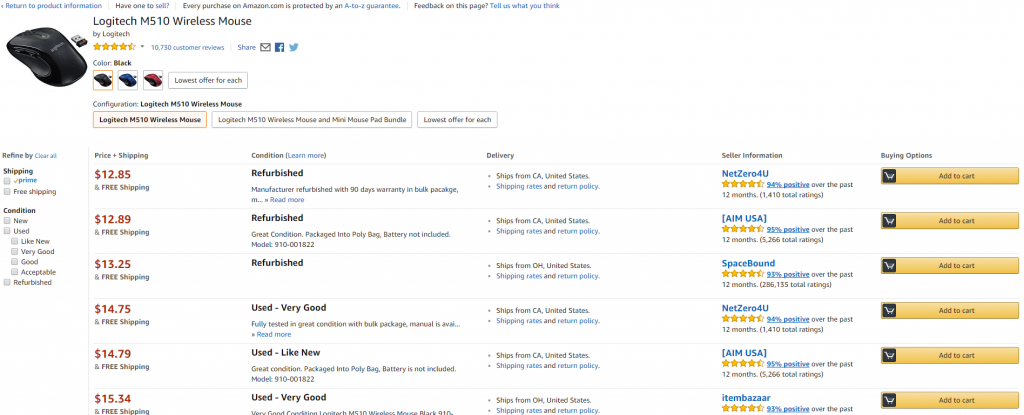
This means that in order to stand out on Amazon, sellers either have to offer a very competitive price or be the only ones to offer this product on Amazon. The latter is usually referred to as “Private label” dropshipping on Amazon. Sellers would create their own brand, usually manufacture the product on pre-ready production lines in China, and this way they can dominate their own product listings on Amazon. This is not pure dropshipping because you need to produce bulk quantities, and invest some cash upfront. This method is great for later stages, when you already have some traction and can predict the demand.
3. Not Building Your Own Asset – Same as with eBay, although you’re generating revenue, on the broader scheme of things you’re helping Amazon enhance its brand, instead of growing your own asset and brand with every new sale.
Once we had our multi-channel dropshipping business running on both eBay and Amazon, at some point we realized that a disproportionate amount of our Amazon orders for filming equipment is coming from London, UK. This led us to a research which taught us that London is considered to be the European Hollywood – a central hub for the EU film making industry.
Following this insight, we decided to build our own webstore aimed at the UK market.
Dropshipping With Your Own Online Store
While Shopify, Bigcommerce and other webstore builders will try to convince you that dropshipping from your own webstore is the easiest way to lift your dropshipping business off the ground, the truth is far from that.
Although there are multiple benefits to dropshipping with your own webstore, for new sellers the disadvantages far outweigh the benefits.
Even with a vast experience in different marketplaces, it took us about 6 months until we began seeing some real traffic and revenues from our webstore. That’s when we were investing around $3,000 every month in marketing the webstore. The reality is that most new sellers don’t have the experience and resources required to generate enough relevant traffic to their webstores, no matter how beautiful and professional these webstores are.
Shopify is a public company, just read their annual report to shareholders and you’ll see that one of the major risk factors for the company is that new sellers are failing at starting their business and are churning from the platform at a very high rate. In fact while we mostly know Shopify as the $29/month webstore builder, this is not their main revenue driver. Most of Shopify’s revenue comes from Shopify plus, a high end webstore platform for enterprise level businesses.
In a recent earnings call, Shopify’s management brought attention to the importance of merchant sales when discussing retention of new sellers.
“…the thing we find is if there is going to be people leaving the platform, generally it’s because they are closing their business. And that happens within that sort of first three to six months period. Once you as a merchant start getting some sales and so time to that first sale is something that we are always looking at how do we improve that for the — or help the merchant to improve that, the churn potential goes down significantly.”
Our own experience shows that for new sellers, the right way to go to increase your chances of survival is to start your dropshipping business from the marketplaces. Dropshipping on Amazon and eBay leaves the heavy lifting of generating traffic to the platforms, while new sellers can focus on other aspects of the business, like sourcing great products and suppliers.
My point here is that you’re much better off starting your dropshipping business on the marketplaces, and only when you’ve established a sustainable revenue, continue to the new adventure called “dropshipping from your own webstore”.
With that said, I’ll mention this again, ask yourself “What can you do better than Amazon?”. Opening your own webstore to sell Apple products is probably not a good idea, as mentioned – Amazon will probably be better at every parameter, from pricing to shipping speed.
Unless you have a unique value proposition, building a dropshipping business from your own webstore will probably fail. Why would a shopper choose your-unknown-webstore.com over Amazon.com if you don’t offer any added value compared to Amazon?
In our case, we were selling professional grade filming equipment which requires a lot of knowledge in the category and expert support which Amazon cannot offer at scale.
Just like with eBay and Amazon we’ve been through lots of ups and downs with our webstore dropshipping experience. We’ve hired an SEO company to promote our webstore and things were going well until Google rolled out their algorithm updates – Panda and Penguin, and we’ve lost over 60% of the traffic overnight. We discovered that the SEO (search engine optimization) done for us wasn’t of high quality – a painful lesson… from that day we only did SEO by ourselves trusting no one with this critical task.
Here’s a Summary of Our Webstore Dropshipping Experience
Benefits of Dropshipping With Your Own Webstore:
- You’re Building Your Own Brand – Every penny you invest, every order you receive is an incremental addition to your brand and asset. When we lost 60% of our traffic due to Google’s algorithm update, we were able to survive due to return customers who trusted us and liked doing business with us. When dropshipping on eBay and Amazon, you can’t expect repeat customers to your specific account, happy shoppers may return to the platform for their next purchase, but they are highly unlikely to look you up as an individual seller.

2. No Selling Fees – As opposed to dropshipping on marketplaces, when dropshipping on your own webstore, you don’t need to pay fees to a 3rd party for enabling the sales.
3. No Need to Comply With Policy Changes – Marketplaces constantly change their requirements and policies, and all sellers must comply. When dropshipping from your own webstore you’re your own master.
4. 100% Control – You have unlimited options to preset your unique value proposition. You define the shoppers experience. When shoppers suggest improvements to the product filters you offer on your site, you can simply implement their requests. You have the freedom and power to build a perfect buying experience for your specific niche, while marketplaces have to offer a generic shopping experience that suits both pencil and yacht shoppers, which obviously is far from being perfect.
Disadvantages of Dropshipping With Your Own Webstore:
- It’s hard! Sellers who try to dropship from their own webstores fail more often than succeed. You need to master a lot of skills;marketing, traffic generation, conversion optimization, brand building, working with comparison shopping engines etc. It takes a lot of time and resources.
- Even with your own webstore, your dropshipping business will heavily rely on other platforms similar to your dependency on eBay and Amazon when dropshipping.
We had comparison shopping engines removing our sites, we were hit by Google’s algorithm update, our webstore was hacked – just to name a few hurdles we had to overcome.
To summarize the topic of dropshipping with your own online store, it’s definitely a profitable venture but you need an additional revenue stream that can keep you afloat while you’re building your brand and climb up search engines rankings. Be prepared for at least a 6-12 months period of hard work before you start seeing any return on your investment, it’s not an immediate revenue stream like dropshipping on Amazon or eBay, no matter how professional your webstore is, you’re just another site out of billions out there, it takes a lot of effort to drive relevant traffic your way.
Four Key Elements That Led to Our Success in Dropshipping

Looking back on nearly a decade in dropshipping, I can distill four key elements that contributed to our success.
- “Failure is not an option” attitude – No matter how desperate things seemed to be, Max and I never even remotely considered quitting. We’ve been through it all – suspended accounts on all our sales channels, our webstore being hacked, the Chinese mail service losing $20K worth of our packages even a customer claiming his child got into the ER because of wrong usage of a sporting product he purchased from us.
No matter how impossible the situation seemed, our mind set was always – Push forward, we’ll get through this. - Aim for the high entry barrier areas – Humans are hardwired to follow the path of least resistance. This is why most sellers dropship from Amazon to eBay, it’s ridiculously easy. No need to look for suppliers, no need to worry about traffic. But the reward is aligned with the effort you invest and the value you create.
Here are some areas where Max and I had to overcome high entry barriers –
– Being Israeli sellers on Amazon – I had to fly to USA to open a bank account. At the time it meant we were among a small group of Israeli dropshippers on Amazon.
– Selling in a niche market that required expertise – we knew nothing about the filmmaking industry when we entered that category.
– Selling on non-English platforms, we generated lot’s of revenue on the German, French and Spanish eBay and Amazon sites.
– We’ve built dedicated webstores for the Scandinavian market, an untapped eCommerce heaven. While Denmark, Sweden and Norway don’t have eBay and Amazon local sites, they have very popular comparison shopping engines – Kelkoo and Pricerunner. It’s a high entry barrier, definitely not as easy as dropshipping on eBay or Amazon, but the reward is subsequently much higher.
– We got out of the comfort zone of our small office, and flew to exhibitions in Europe to establish relationships with new and existing dropshipping suppliers. - Being obsessive about customers satisfaction – Our early days on eBay taught us that our reputation as a business is worth much more than the short term profit. We were living up to this strategy and truly going out of our way to make sure our customers were satisfied, no matter what. This is especially tough when you’re starting out and every penny counts, but it served us well in the long run.
- Long term thinking – Here are a few examples:
- We’ve never pulled in high salaries, prefering to invest all profits into growing the dropshipping business.
- When UK customers started requesting tax invoices, we’ve opened a dedicated UK company which meant losing about 50% of the profitability, but we knew that if we’re serious about serving the professional film making market in the UK, we had to invest in localizing the business.
- Realizing that professional eBay listings increase conversion and sales, we started treating our listings as a process rather than a one time creation. We were constantly trying new designs and elements on our listings, some led to a decrease in sales, while others increased them. Over the course of constantly optimizing our listings we were able to increase our eBay dropshipping business by 220%.
Two Deadly Mistakes That Almost Killed Our Dropshipping Business

- Neglecting accounting – Typical to first time entrepreneurs, Max and I were focused on growing the business, listing new products, meeting new supplier and onboarding new employees. While running forward, we neglected our accounting, which meant that we didn’t have a clear view of the monthly cash flow. We had to learn the lesson here the hardest way there is, when we had to let go of half of our 14 employees because our cash flow wasn’t sufficient to sustain such a team. At such a small company that literally meant having to fire good friends and great employees.
- Relying on one sales channel – We’ve been exclusively dropshipping on eBay years before expanding to other sales channels. We had to deal with Paypal disputes, removed listings and suspended eBay accounts. That’s tough and highly discouraging, especially so when we were doing everything in our power to provide an awesome experience to our customers. Looking back – I would expand our dropshipping business beyond eBay much earlier to save us the numerous near bankruptcy experiences.
The image below was taken at the top of the Triglav mountain in Slovenia. Max and I climbed to the top for 2 days. A day before we started the trek, eBay sent us an email saying that our best selling listing was removed, which basically meant that we’ve lost 90% of our revenue. At that point that one listing was most of our dropshipping business.
Having to cope with the physical difficulty of climbing the Triglav mountain, as well as the mental burden of knowing we’re out of business and there’s nothing we can do about it, summarizes our dropshipping journey. It’s hard, most chances you’ll fail, but if you’re crazy enough to believe you’ll succeed, and stubborn enough to keep going no matter what, I can guarantee, you’ll reach the top.
Good luck!





